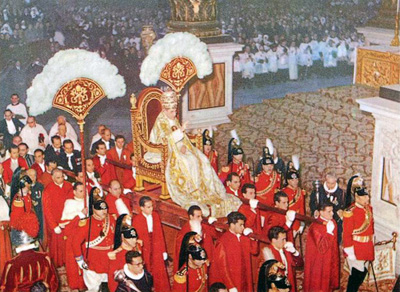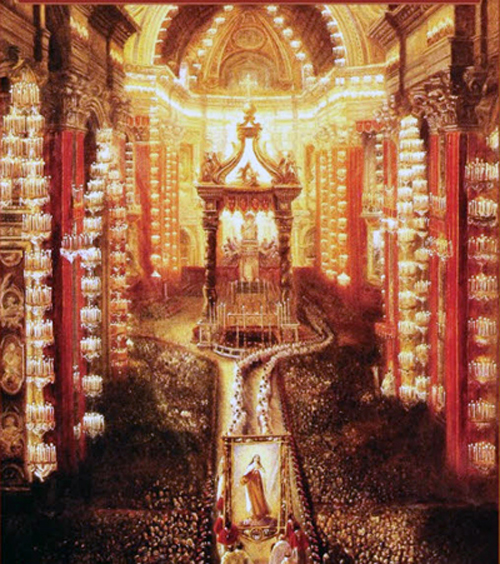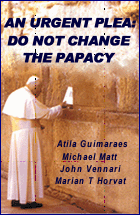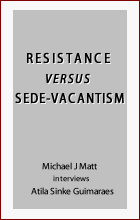About the Church
 |
 |
 |
 |
 |
 |
 |
Poverty and Richness: Harmonic Extremes
in the Church’s Firmament

In a shadow-filled cell, before a Crucifix that reminds us of the most sorrowful death that ever was, a Carthusian monk pages through a devotional book.
With his poor, simple habit and long beard, this religious man seems to personify the whole ambience that surrounds him: extreme seriousness, a manly resolution to live only for what is profound, true and eternal, a noble simplicity, the spirit of the renunciation of all earthly goods; in short, material poverty illuminated by the supernatural action of the highest spiritual wealth.
Another aspect of the Church
In the next picture below left, we find another aspect of the Holy Church.
In the immense nave of St. Peter’s Basilica, a papal cortege is majestically advancing. In the photograph we see only a part of this cortege. In it is the Supreme Pontiff, flanked by the famous flabelli and by the Noble Guard.

While the first photograph is a picture of recollected seriousness, the other is one of radiant glory. In one everything is poverty, in the other everything is richness. One represents simplicity, the other shows the height of refinement. And while one represents the renunciation of creatures, the other represents the splendor creatures can make to honor God’s Vicar on earth.
A contradiction? Many might ask: Is it possible to simultaneously love richness and poverty, pomp and simplicity, display and recollection? Can one praise the abandonment of all earthly things and, at the same time, admire this ceremonial where the highest earthly values shine?
These are very timely questions …
No, there is no contradiction between these two orders of values, except in the minds of the egalitarian servants of the Revolution. To the contrary, the Church manifests her holiness precisely because – with equal perfection and with the same supernatural originality – she knows how to organize and stimulate the practice of virtues that shines in the obscure life of the monk and gleams in the sublime ceremonial of the Papacy. What is more, one thing balances the other. We could even say that the one extreme – in the good sense of the word – compensates for the other and harmonizes with it.
The doctrinal ground upon which these two holy extremes are founded and harmonized is very clear. God Our Lord gave us the things of this world so that they might help us to reach Him. Thus, it is fitting that culture and art, inspired by Faith, should highlight all the splendors of created things as well as all the splendors of human talents and virtues. It is what we call Christian culture and civilization.
With this, men are formed in truth and beauty, in love of sublimity, hierarchy and order, which in the universe mirrors the perfection of the One who made it. Thus, created things serve for our salvation and divine glory.
But, on the other hand, all created things are contingent and transitory. Only God is absolute and eternal. It behooves us to remember this. And so it is good to withdraw from the world and consider it with contempt in order to think only on Our Lord.
Through the one way we love God by considering what His creatures are; through the other, by considering what they are not. The Church invites her children to travel both ways simultaneously – by considering both the sublime display of her pomp and also the admirable renunciations that only she knows effectively how to inspire and achieve.

A magnificent beatification ceremony in St. Peter's Basilica, before Vatican II

Catolicismo n. 96, December 1958
Posted April 8, 2013
Posted April 8, 2013








